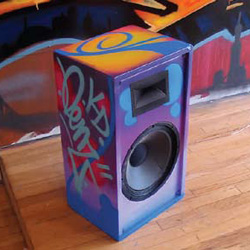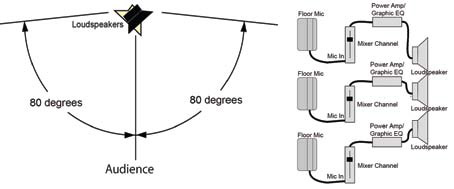
Hanging & Mounting
In a theater used for drama or musicals, there might be the need to place the loudspeakers closer to the audience than a typical over-the-stage location.
Options include hanging the loudspeakers over the audience (high enough to not block the view of the stage); mounting the loudspeakers on portable stands; and mounting the loudspeakers on the side walls (if enough coverage can be delivered to the center of the audience).
Keep in mind that the flying of loudspeakers must be done by a licensed professional rigger who follows safety standards.
Delay To Extend
For larger coverage areas, there might be the need to place additional loudspeakers 50 feet or more from the stage. This is not quite as simple as we sometimes make it out to be. It’s important to delay the signal to these loudspeakers so that sound localizes on stage rather than at the nearest loudspeaker.
This technique utilizes the Haas (or precedence) effect, which states that humans localize sound to the earliest sound-wave arrival. For our discussion here, I’m assuming that the system has a digital processor for setting/optimizing delay settings.
Delay time—T—is critical. On the processor, set T slightly greater than D/C, where T = delay time in seconds, D = distance (in feet) from the performers on stage to the audience near the loudspeakers, and C = speed of sound (1,130 feet per second).
For example, suppose the audience members who are near the loudspeakers are 30 feet from the actors. Delay the signal to the loudspeakers slightly more than D/C, or 30/1,130, which is .026 second (26 milliseconds).
This will insure the audience hears the sound as if it originated on stage instead of the nearest loudspeaker, because the first arrival of sound at their ears will actually indeed be from the stage. The same concept applies when utilizing compact loudspeakers in performance venues to cover listening areas under balconies where the output of the main loudspeakers is shadowed.
Creative Necessities
Now let’s investigate a few unusual methods that can help in troublesome situations.
A/B Technique: Suppose you’re using a few floor microphones for sound reinforcement of actors and want the amplified volume to be as high as possible without feedback occurring. One way to do it is to reduce the number of open microphones. Every time the number of open or “on” microphones is cut in half, gain-before-feedback (GBF) increases 3 dB.
So if you start with four mics and turn up only two, GBF goes up 3 dB. If you turn up only one mic, GBF goes up 6 dB—a big improvement.
Using fewer mics also increases clarity by reducing the pickup of ambient sound reflections.
When two mics pick up the same actor, you hear the actor’s voice doubled or smeared in time, which causes comb filtering or a hollow, muddy sound. Ideally, one mic’s fader is turned up at a time, following the action on stage. Of course, that can be inconvenient, as the sound mixer will be occupied for the entire show. An approach called the A/B Technique makes riding the faders unnecessary.
By the way, I also call this the “one speaker per mic” method, and other names might be “one PA system per mic” or “one amp channel per mic.”

